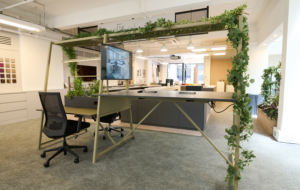|
|
||
|
It was a busy Saturday afternoon in Brighton city centre, and I was on my way to rob a bank. I had my mobile phone, an accomplice, and his mobile phone. Standing opposite Barclays bank, we gazed at each other and stood with phones clamped to our ears, poised for action. I could press one to continue or two if I wasn’t ready. We signalled to each other, then touched our keypads. This was the climax of A Machine To See With, a pervasive game by interactive media artist group Blast Theory which put participants on the streets among unsuspecting members of the public, appropriating the surroundings as the props and backdrop for its storyline. It was a fictitious thriller played in real time on the high street; a bank heist by numbers. Three hours before starting A Machine To See With, I got a phonecall instructing me to be outside the Brighton Toy and Model Museum at 3.15pm with a fully charged phone and some cash. I was an avatar in what followed, a remote-controlled machine to see with, obeying automated commands on my phone, confirming my progress by selecting certain options the system offered. Being on my phone kept me slightly removed from my surroundings, a little apart from the shoppers, tourists and boisterous stag parties. Then, in the toilets of a pub, my judgement and instincts were brought into play as I answered questions about what kind of bank robber I was. Selecting option two rather than three was all that would define me. I might sometimes take the lead in tricky situations in real life, but I would have to at all times in this game, as that was the option selected. This live action Choose Your Own Adventure game was now complicated by the added personality test. At the top of the car park, I had to find an unlocked silver BMW then sit in the driver’s seat and wait for a tap on the window. Shit just got real; this was interaction with non-game objects, real places and people; they were part of the game, although they appeared not to be playing at all. Juggling these realities was challenging, thrilling; when another player tapped hesitantly on the window and got into the car with me, it became clear how many other realities were present. There was a different pre-recorded voice guiding him; he was told to look at me the same moment my automated message told me to look at him. We exchanged brief words, decided to work together, and nervously went downstairs to rob the bank. We didn’t rob it. At the crucial moment, I was told to turn away. My accomplice had already disappeared. Did we really think we would? the voice asked. I couldn’t answer as there was no option to express myself. More commands came: go to the games arcade near the seafront, then find someone among the garish, coin-operated machines, and give them my money. I selected an option, finger quivering, and listened to my final damning message. Then the line went dead, and I looked around, dazed. There were people on their phones, all plugged into a removed reality as I had been, perhaps playing a game in which they too negotiated the streets as if pieces in a board game. We were complicit. These strangers not making eye contact or watching where they were going were, for that moment, my friends. I was a machine, seeing things differently. A Machine To See With, Blast Theory. Brighton Digital Festival, 2011 |
Image A Machine To See With
Words Hazel Tsoi-Wiles |
|
|
||
















